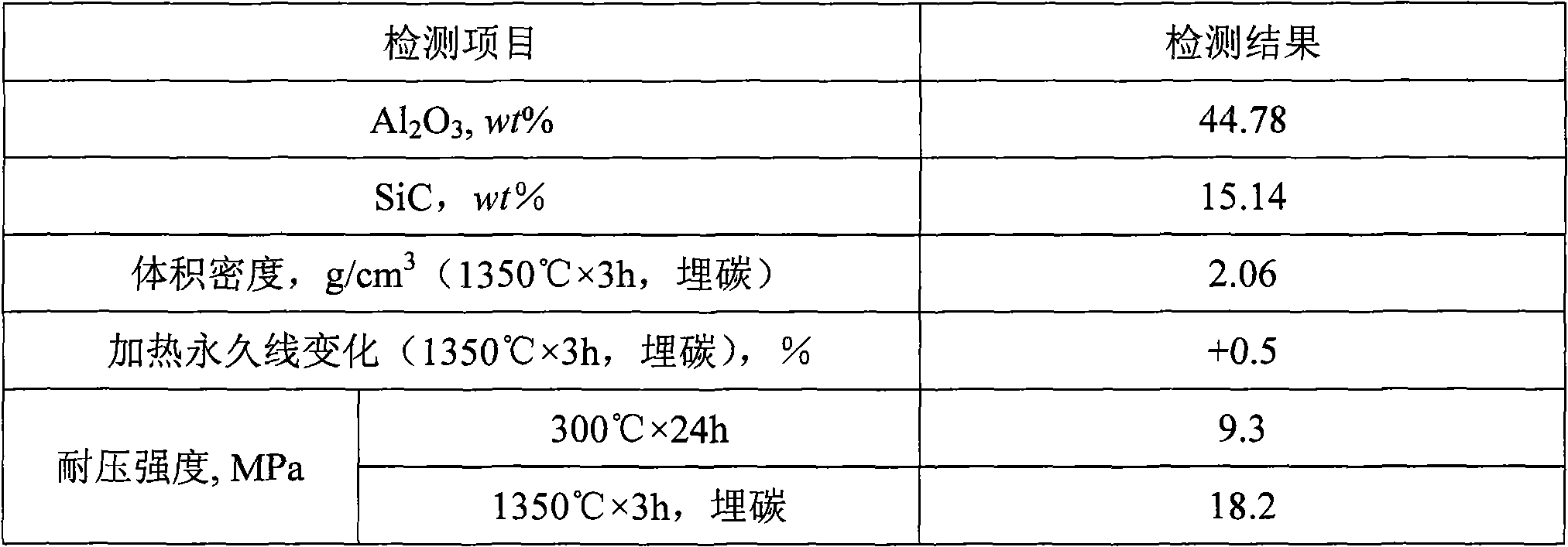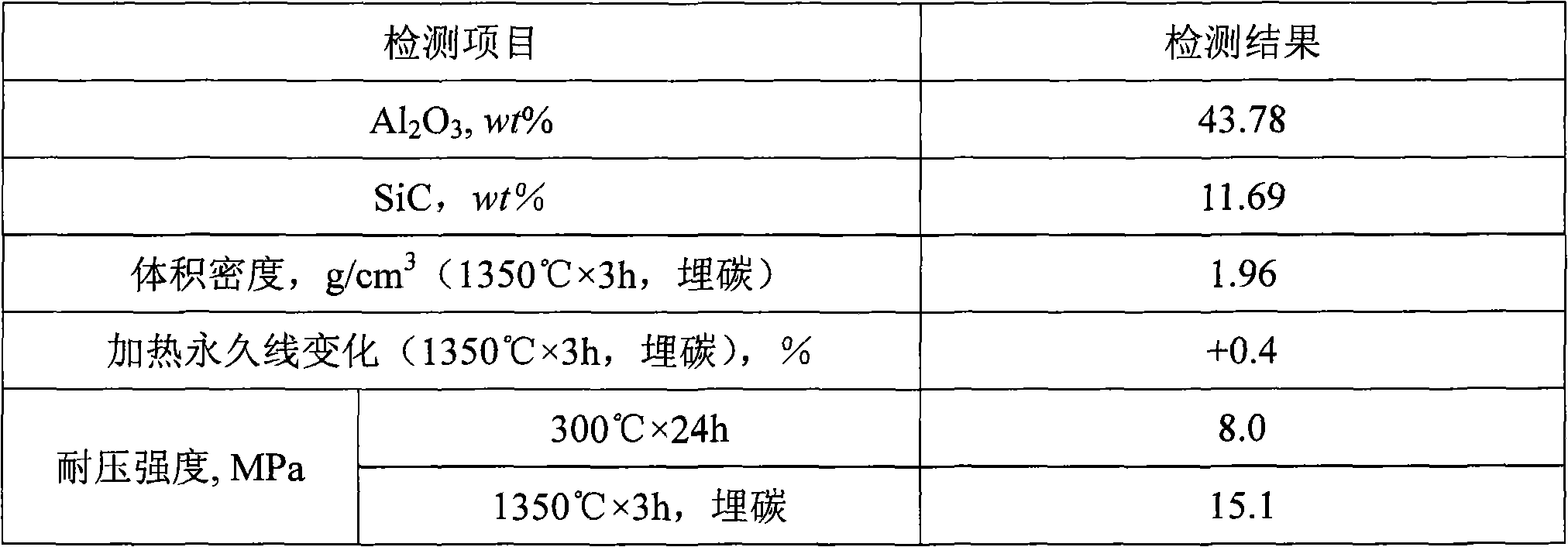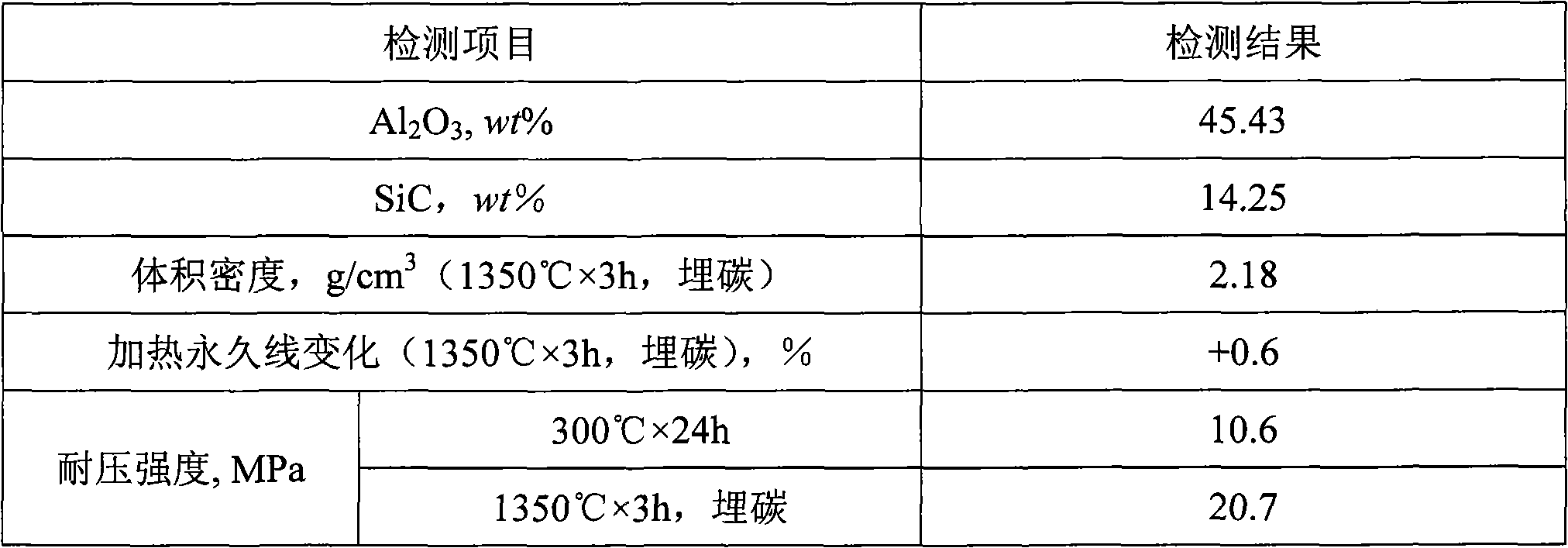Method for producing waterless taphole mix for blast furnace from high-alumina waste refractory materials
A technology of waste refractory materials and anhydrous taphole mud, which is applied in the field of blast furnace anhydrous taphole mud, which can solve the problems of inability to ensure the smooth operation of the blast furnace, leakage of molten iron from molten blast furnace mud, and reduce the cost of blast furnace mud, achieving excellent slag resistance, Emission reduction and low cost effects
- Summary
- Abstract
- Description
- Claims
- Application Information
AI Technical Summary
Problems solved by technology
Method used
Image
Examples
Embodiment 1
[0039] The waste refractory material used is the used blast furnace iron trough material, which is processed into particles and fine powder. The used blast furnace iron trough material contains 70.32% of alumina, 14.47% of silicon carbide and 2.85% of carbon. . All the raw materials of brown corundum and excellent bauxite in the original gun mud are replaced. Because they contain silicon carbide and carbon, they partially replace silicon carbide and coke powder. The mass percentage ratio of each component is as follows:
[0040] After used blast furnace iron trough material particles 5-3mm 10%
[0041] After use blast furnace iron trough material particles 3-1mm 20%
[0042] After use, the blast furnace iron trough material particles are less than 1mm 20%
[0043] After use, the blast furnace iron groove fine powder is less than 0.088mm 10%
[0044] Silicon carbide particles less than 1mm 2%
[0045] Silicon carbide fine powder is less than 0.088mm 5%
[0047] Asp...
Embodiment 2
[0058] The used waste refractory material is the used ladle slide plate, which is processed into particles and fine powder. After use, the ladle slide plate has an alumina mass ratio content of 65.27% and a carbon mass ratio content of 6.85%. Most of them replace brown corundum and part of coke powder. The mass percentage ratio of each component is as follows:
[0059] After use, ladle slide particles 5-3mm 10%
[0060] After use, ladle slide particles 3-1mm 20%
[0061] After use, the ladle sliding plate particles are less than 1mm 20%
[0062] Brown corundum fine powder less than 0.088mm 12%
[0063] Silicon carbide particles less than 1mm 5%
[0064] Silicon carbide fine powder is less than 0.088mm 8%
[0065] Coke powder 3%
[0066] Asphalt powder 6%
[0067] Clay powder 10%
[0068] Silica powder 4%
[0069] Sericite powder 2%
[0070] The additional binder is tar, which accounts for 14% of the total mass of the ingredients.
[0071] After accurately weighing the various ingredients, add ...
Embodiment 3
[0076] The used waste refractory material is the combination of the used ladle seat brick and the used ladle breathable brick, the used ladle seat brick has an alumina mass ratio content of 88.38%, and the used ladle breathable brick alumina mass ratio content is 90.67%. The two are processed into granules and fine powder to replace the brown corundum and excellent bauxite raw materials in the gun mud. The mass percentage ratio of each component is as follows:
[0077] Ladle seat brick particles 5-3mm 10% after use
[0078] Ladle seat brick particles 3-1mm 15% after use
[0079] After use, the size of ladle seat bricks is less than 1mm 15%
[0080] After use, the fine powder of ladle breathable brick is less than 0.088mm 12%
[0081] Silicon carbide particles less than 1mm 5%
[0082] Silicon carbide fine powder less than 0.088mm 10%
[0083] Coke powder 8%
[0084] Asphalt powder 6%
[0085] Clay powder 10%
[0086] Kyanite powder 4%
[0087] Iron silicon nitride powder 5%
[0088] The exter...
PUM
| Property | Measurement | Unit |
|---|---|---|
| Diameter | aaaaa | aaaaa |
| Length | aaaaa | aaaaa |
Abstract
Description
Claims
Application Information
 Login to View More
Login to View More - R&D
- Intellectual Property
- Life Sciences
- Materials
- Tech Scout
- Unparalleled Data Quality
- Higher Quality Content
- 60% Fewer Hallucinations
Browse by: Latest US Patents, China's latest patents, Technical Efficacy Thesaurus, Application Domain, Technology Topic, Popular Technical Reports.
© 2025 PatSnap. All rights reserved.Legal|Privacy policy|Modern Slavery Act Transparency Statement|Sitemap|About US| Contact US: help@patsnap.com



